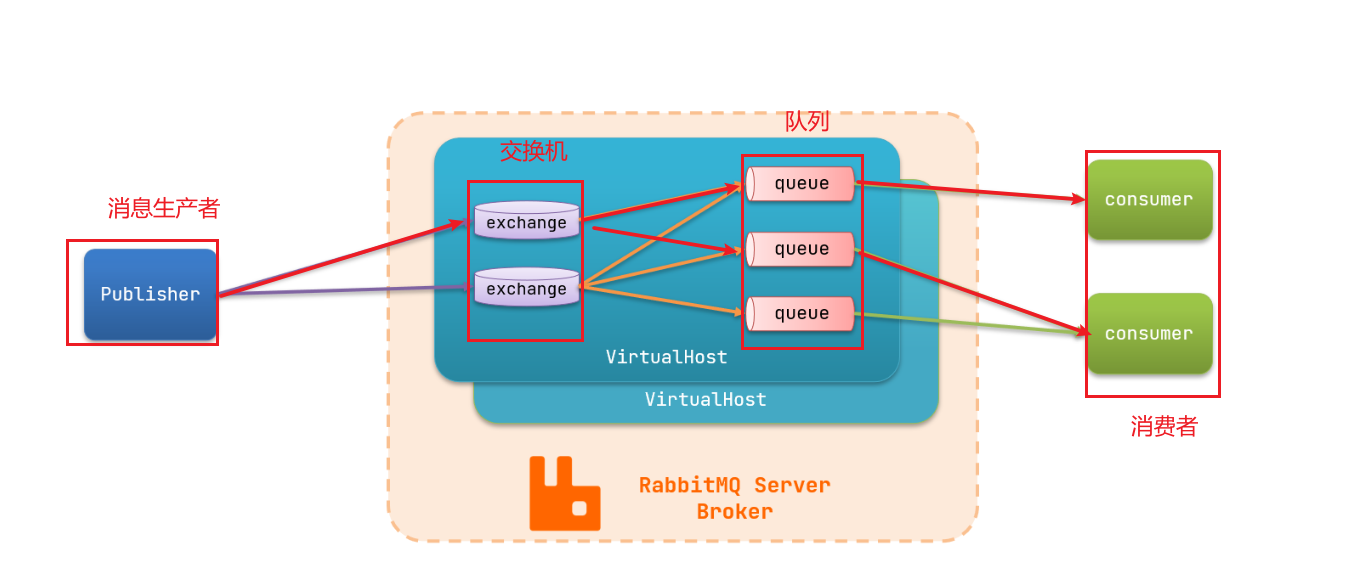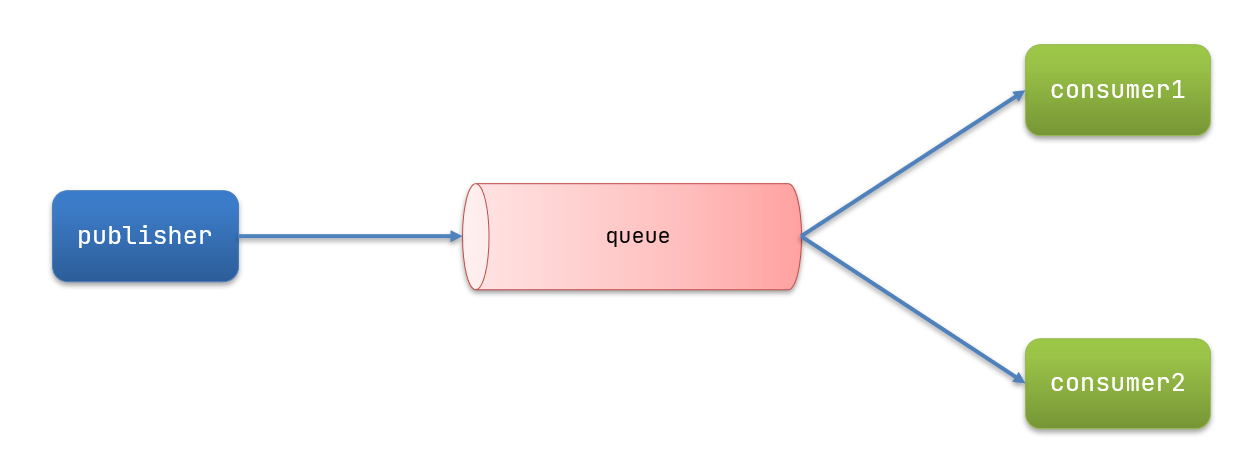RabbitMQ
MQ,中文是消息队列(MessageQueue),字面来看就是存放消息的队列。也就是事件驱动架构中的Broker。
比较常见的MQ实现:RabbitMQ、RocketMQ、Kafka
同步和异步通讯
- 同步通讯:
- 优点:
- 时效性强,可以立即得到结果
- 缺点:
- 耦合度高:每次加入新的需求都要修改原来的代码
- 性能下降:调用者需要等待服务提供者响应,等于所有调用服务的响应时间之和
- 资源浪费:调用链中的每个服务在等待响应的过程中,不能释放请求占用的资源
- 级联失败:如果服务提供者出现问题,所有调用方都会出现问题,导致整个微服务群故障
- 优点:
- 异步通讯:
- 优点:
- 吞吐量提升:无需等待订阅者处理完成,响应更快
- 故障隔离:服务没有直接调用,不存在级联问题
- 调用间没有阻塞,不会造成无效的资源占用
- 耦合度极低:每个服务都可以灵活插拔
- 流量削峰:不管发布事件的流量波动多大,都由Broker接收,订阅者可以按照自己的速度处理事件
- 缺点:
- 架构复杂的情况下,业务没有明显的流程线,不好管理
- 依赖于Broker的可靠性
- 优点:
RabbitMQ部署
# 拉取镜像
docker pull rabbitmq:3-management
# 部署
docker run \
-e RABBITMQ_DEFAULT_USER=root \
-e RABBITMQ_DEFAULT_PASS=root \
-v mq-plugins:/plugins \
--name mq \
--hostname mq \
-p 15672:15672 \
-p 5672:5672 \
-d \
rabbitmq:3-management
RabbitMQ消息模型
官方地址:https://www.rabbitmq.com/getstarted.html
- publisher:消息发布者,将消息发送到队列queue
- queue:消息队列,负责接受并缓存消息
- consumer:订阅队列,处理队列中的消息
- 消息模型:
- 简单模型
- 工作队列模型:Workqueues
- 发布订阅模型:Publish
- 路由模型:Routing
- 主题模型:Topics
- RPC
- Publisher Confirms
原生RabbitMQ实现(了解)
package cn.itcast.mq.helloworld;
import com.rabbitmq.client.*;
import java.io.IOException;
import java.util.concurrent.TimeoutException;
public class ConsumerTest {
public static void main(String[] args) throws IOException, TimeoutException {
// 1.建立连接
ConnectionFactory factory = new ConnectionFactory();
// 1.1.设置连接参数,分别是:主机名、端口号、vhost、用户名、密码
factory.setHost("192.168.65.182");
factory.setPort(5672);
factory.setVirtualHost("/");
factory.setUsername("root");
factory.setPassword("root");
// 1.2.建立连接
Connection connection = factory.newConnection();
// 2.创建通道Channel
Channel channel = connection.createChannel();
// 3.创建队列
String queueName = "simple.queue";
channel.queueDeclare(queueName, false, false, false, null);
// 4.订阅消息
channel.basicConsume(queueName, true, new DefaultConsumer(channel){
@Override
public void handleDelivery(String consumerTag, Envelope envelope,
AMQP.BasicProperties properties, byte[] body) throws IOException {
// 5.处理消息
String message = new String(body);
System.out.println("接收到消息:【" + message + "】");
}
});
System.out.println("等待接收消息。。。。");
}
}
package cn.itcast.mq.helloworld;
import com.rabbitmq.client.Channel;
import com.rabbitmq.client.Connection;
import com.rabbitmq.client.ConnectionFactory;
import org.junit.Test;
import java.io.IOException;
import java.util.concurrent.TimeoutException;
public class PublisherTest {
@Test
public void testSendMessage() throws IOException, TimeoutException {
// 1.建立连接
ConnectionFactory factory = new ConnectionFactory();
// 1.1.设置连接参数,分别是:主机名、端口号、vhost、用户名、密码
factory.setHost("192.168.65.182");
factory.setPort(5672);
factory.setVirtualHost("/");
factory.setUsername("root");
factory.setPassword("root");
// 1.2.建立连接
Connection connection = factory.newConnection();
// 2.创建通道Channel
Channel channel = connection.createChannel();
// 3.创建队列
String queueName = "simple.queue";
channel.queueDeclare(queueName, false, false, false, null);
// 4.发送消息
String message = "hello, rabbitmq!";
channel.basicPublish("", queueName, null, message.getBytes());
System.out.println("发送消息成功:【" + message + "】");
// 5.关闭通道和连接
channel.close();
connection.close();
}
}
SpringAMQP
SpringAMQP是基于RabbitMQ封装的一套模板,并且还利用SpringBoot对其实现了自动装配。
相关配置
在父模块中导入依赖
<!--AMQP依赖,包含RabbitMQ--> <dependency> <groupId>org.springframework.boot</groupId> <artifactId>spring-boot-starter-amqp</artifactId> </dependency>在发布者和订阅者的application.yml中添加配置
logging: pattern: dateformat: MM-dd HH:mm:ss:SSS spring: rabbitmq: host: 192.168.65.182 port: 5672 username: root password: root virtual-host: /
消息转换器
Spring发送消息时,默认采用JDK序列化将信息发送给MQ,接收消息的时候,还会把字节反序列化为Java对象。
存在 数据体积过大、有安全漏洞、可读性差 的问题。
解决方式-配置JSON转换器
在父模块中导入依赖
<dependency> <groupId>com.fasterxml.jackson.dataformat</groupId> <artifactId>jackson-dataformat-xml</artifactId> <version>2.9.10</version> </dependency> <dependency> <groupId>com.fasterxml.jackson.core</groupId> <artifactId>jackson-databind</artifactId> <version>2.9.10.5</version> </dependency>在发布者和订阅者的启动类中都添加以下Bean
//配置消息转换器 @Bean public MessageConverter jsonMessageConverter(){ return new Jackson2JsonMessageConverter(); }
简单模型
消息队列
@Configuration @Slf4j public class RabbitConfig { //=========简单模型========= //声明一个队列,名字为simple.queue @Bean public Queue simpleQueue() { return new Queue("simple.queue"); }监听器
package cn.itcast.mq.listener; import lombok.extern.slf4j.Slf4j; import org.springframework.amqp.rabbit.annotation.RabbitListener; import org.springframework.stereotype.Component; @Component @Slf4j public class SimpleQueueListener { /** * 这个方法是一个回调方法,只要队列列队里面有消息,就会调用该方法 * 并且把队列的消息的内容传递给方法的形参message */ //=========简单模型========= @RabbitListener(queues = "simple.queue") public void listener(String message) { log.info("simple.listener消费消息:" + message); } }消息发布
package cn.itcast.mq; import org.junit.jupiter.api.Test; import org.springframework.amqp.rabbit.core.RabbitTemplate; import org.springframework.beans.factory.annotation.Autowired; import org.springframework.boot.test.context.SpringBootTest; @SpringBootTest public class SimpleQueueSend { //使用springAMQP一定要创建核心类 @Autowired private RabbitTemplate rabbitTemplate; @Test public void sendMessage(){ String message = "简单模型生产的消息"; String queueName = "simple.queue"; rabbitTemplate.convertAndSend(queueName,message); } }
队列模型
多个消费者绑定到一个队列,同一条消息只会被一个消费者处理
消息队列
//=========队列模型========= @Bean public Queue workQueue() { return new Queue("work.queue"); }监听器
package cn.itcast.mq.listener; import lombok.extern.slf4j.Slf4j; import org.springframework.amqp.rabbit.annotation.RabbitListener; import org.springframework.stereotype.Component; @Component @Slf4j public class WorkQueueListener { //=========队列模型========= @RabbitListener(queues = "work.queue") public void listener1(String message) throws InterruptedException { log.info("work.listener1消费的消息:" + message); Thread.sleep(500); } @RabbitListener(queues = "work.queue") public void listener2(String message){ log.info("work.listener2消费的消息:" + message); } }消息发布
package cn.itcast.mq; import org.junit.jupiter.api.Test; import org.springframework.amqp.rabbit.core.RabbitTemplate; import org.springframework.beans.factory.annotation.Autowired; import org.springframework.boot.test.context.SpringBootTest; @SpringBootTest public class WorkQueueSend { //使用springAMQP一定要创建核心类 @Autowired private RabbitTemplate rabbitTemplate; @Test public void sendMessage() { String message = "队列模型生产的消息"; String queueName = "work.queue"; for (int i = 1; i <= 10; i++) { rabbitTemplate.convertAndSend(queueName, i + ":" + message); } } }能者多劳
# 默认是轮询消费消息队列 spring: rabbitmq: listener: simple: prefetch: 1 # 每次只能获取一条消息,处理完成才能获取下一个消息
发布订阅模型
Exchange(交换机):只负责转发消息,不具备存储消息的能力。
交换机类型:
- Fanout:广播,将消息交给所有绑定到交换机的队列
- Direct:定向,把消息交给符合指定routing key 的队列
- Topic:通配符,把消息交给符合routing pattern(路由模式) 的队列
消息队列
//=========发布订阅模型========= //定义一个广播交换机 @Bean public FanoutExchange fanoutExchange() { return new FanoutExchange("fanout.exchange"); } //定义两个队列 @Bean public Queue fanoutQueue1() { return new Queue("fanout.queue1"); } @Bean public Queue fanoutQueue2() { return new Queue("fanout.queue2"); } //把队列绑定到交换机上 @Bean public Binding bindingQueue1(FanoutExchange fanoutExchange, Queue fanoutQueue1) { return BindingBuilder.bind(fanoutQueue1).to(fanoutExchange); } @Bean public Binding bindingQueue2(FanoutExchange fanoutExchange, Queue fanoutQueue2) { return BindingBuilder.bind(fanoutQueue2).to(fanoutExchange); }监听器
package cn.itcast.mq.listener; import lombok.extern.slf4j.Slf4j; import org.springframework.amqp.rabbit.annotation.RabbitListener; import org.springframework.stereotype.Component; @Component @Slf4j public class FanoutQueueListener { //=========发布订阅模型========= @RabbitListener(queues = "fanout.queue1") public void listener1(String message){ log.info("fanout.listener1消费的消息:" + message); } @RabbitListener(queues = "fanout.queue2") public void listener2(String message){ log.info("fanout.listener2消费的消息:" + message); } }消息发布
package cn.itcast.mq; import org.junit.jupiter.api.Test; import org.springframework.amqp.rabbit.core.RabbitTemplate; import org.springframework.beans.factory.annotation.Autowired; import org.springframework.boot.test.context.SpringBootTest; @SpringBootTest public class FanoutQueueSend { //使用springAMQP一定要创建核心类 @Autowired private RabbitTemplate rabbitTemplate; @Test public void sendMessage() { String message = "发布订阅模型生产的消息"; String exchangeName = "fanout.exchange"; //参数一:交换机 参数二:路由key , 参数三:消息 rabbitTemplate.convertAndSend(exchangeName, "", message); } }
路由模型
Direct:定向,把消息交给符合指定routing key 的队列
消息队列
//=========路由模型========= //方式一:@Bean实现 //定义一个路由交换机 /*@Bean public DirectExchange directExchange(){ return new DirectExchange("direct.exchange"); } //定义两个队列 @Bean public Queue directQueue1(){ return new Queue("direct.queue1"); } @Bean public Queue directQueue2(){ return new Queue("direct.queue2"); } //把队列绑定到交换机上 @Bean public Binding bindingQueue3(DirectExchange directExchange, Queue directQueue1){ return BindingBuilder.bind(directQueue1).to(directExchange).with("user"); } @Bean public Binding bindingQueue4(DirectExchange directExchange, Queue directQueue2){ return BindingBuilder.bind(directQueue2).to(directExchange).with("order"); }*/ //方式二:@RabbitListener注解实现 /** * QueueBinding注解的作用: * 1. 在运行的时候如果发现rabbitmq里面没有对应的交换机、队列,就会马上创建交换机与队列 * 2. 如果Rabbitmq中一旦存在对应交换机与队列,那么就只有监听队列的作用。 */ @RabbitListener(bindings = { @QueueBinding( //定义交换机 exchange = @Exchange(name = "direct.exchange", type = ExchangeTypes.DIRECT), //定义队列 value = @org.springframework.amqp.rabbit.annotation.Queue("direct.queue1"), //路由key key = "user" ) }) public void directListener1(String message) { log.info("direct.listener1消费的消息:" + message); } @RabbitListener(bindings = { @QueueBinding( //定义交换机 exchange = @Exchange(name = "direct.exchange", type = ExchangeTypes.DIRECT), //定义队列 value = @org.springframework.amqp.rabbit.annotation.Queue("direct.queue2"), //路由key key = "order" ) }) public void directListener2(String message) { log.info("direct.listener2消费的消息:" + message); }监听器
package cn.itcast.mq.listener; import lombok.extern.slf4j.Slf4j; import org.springframework.amqp.rabbit.annotation.RabbitListener; import org.springframework.stereotype.Component; @Component @Slf4j public class DirectQueueListener { //=========路由模型========= //方式一:@Bean实现的情况下才需要单独写listener //方式二:@RabbitListener注解实现不需要单独写 /* @RabbitListener(queues = "direct.queue1") public void listener1(String message){ log.info("direct.listener1消费的消息:" + message); } @RabbitListener(queues = "direct.queue2") public void listener2(String message){ log.info("direct.listener2消费的消息:" + message); }*/ }消息发布
package cn.itcast.mq; import org.junit.jupiter.api.Test; import org.springframework.amqp.rabbit.core.RabbitTemplate; import org.springframework.beans.factory.annotation.Autowired; import org.springframework.boot.test.context.SpringBootTest; @SpringBootTest public class DirectQueueSend { //使用springAMQP一定要创建核心类 @Autowired private RabbitTemplate rabbitTemplate; @Test public void sendMessage() { String message = "路由模型生产的user消息"; String exchangeName = "direct.exchange"; String routingKey = "user"; //参数一:交换机 参数二:路由key , 参数三:消息 rabbitTemplate.convertAndSend(exchangeName, routingKey, message); } }
主题模型
Routingkey 一般都是有一个或多个单词组成,多个单词之间以”.”分割,例如: item.insert
通配符规则:
#:匹配一个或多个词
*:匹配不多不少恰好1个词
举例:
item.#:能够匹配item.spu.insert 或者 item.spu
item.*:只能匹配item.spu
消息队列
//=========主题模型========= @RabbitListener(bindings = { @QueueBinding( //定义交换机 exchange = @Exchange(name = "topic.exchange", type = ExchangeTypes.TOPIC), //定义队列 value = @org.springframework.amqp.rabbit.annotation.Queue("topic.queue1"), //路由key key = "work.#" ) }) public void topicListener1(String message) { log.info("topic.listener1消费的消息:" + message); } @RabbitListener(bindings = { @QueueBinding( //定义交换机 exchange = @Exchange(name = "topic.exchange",type = ExchangeTypes.TOPIC), //定义队列 value = @org.springframework.amqp.rabbit.annotation.Queue("topic.queue2"), key = "work.*" ) }) public void topicListener2(String message){ log.info("topic.listener2消费的消息:" + message); } }消息发布
package cn.itcast.mq; import org.junit.jupiter.api.Test; import org.springframework.amqp.rabbit.core.RabbitTemplate; import org.springframework.beans.factory.annotation.Autowired; import org.springframework.boot.test.context.SpringBootTest; @SpringBootTest public class TopicQueueSend { //使用springAMQP一定要创建核心类 @Autowired private RabbitTemplate rabbitTemplate; @Test public void sendMessage() { String message = "主题模型生产的消息"; String exchangeName = "topic.exchange"; String routingKey = "work.SZ.top100"; //参数一:交换机 参数二:路由key , 参数三:消息 rabbitTemplate.convertAndSend(exchangeName, routingKey, message); } }




